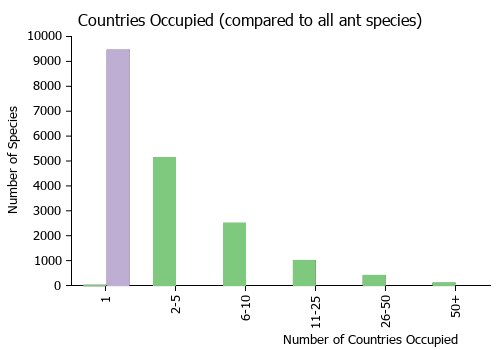Strumigenys thomae
| Strumigenys thomae | |
|---|---|
| Scientific classification | |
| Kingdom: | Animalia |
| Phylum: | Arthropoda |
| Class: | Insecta |
| Order: | Hymenoptera |
| Family: | Formicidae |
| Subfamily: | Myrmicinae |
| Tribe: | Attini |
| Genus: | Strumigenys |
| Species: | S. thomae |
| Binomial name | |
| Strumigenys thomae Kempf, 1976 | |
Nothing is known about the biology of Strumigenys thomae.
Identification
Bolton (2000) - A member of the Strumigenys precava-group. The dense sharp longitudinally costulate sculpture that blankets the first gastral tergite immediately distinguishes thomae from the other members of the group.
Keys including this Species
Distribution
Latitudinal Distribution Pattern
Latitudinal Range: -1.456° to -1.456°.
| North Temperate |
North Subtropical |
Tropical | South Subtropical |
South Temperate |
- Source: AntMaps
Distribution based on Regional Taxon Lists
Neotropical Region: Brazil (type locality).
Distribution based on AntMaps
Distribution based on AntWeb specimens
Check data from AntWeb
Countries Occupied
| Number of countries occupied by this species based on AntWiki Regional Taxon Lists. In general, fewer countries occupied indicates a narrower range, while more countries indicates a more widespread species. |

|
Estimated Abundance
| Relative abundance based on number of AntMaps records per species (this species within the purple bar). Fewer records (to the left) indicates a less abundant/encountered species while more records (to the right) indicates more abundant/encountered species. |

|
Biology
Castes
Nomenclature
The following information is derived from Barry Bolton's Online Catalogue of the Ants of the World.
- thomae. Strumigenys thomae Kempf, 1976b: 39, figs. 1-3 (w.) BRAZIL. See also: Bolton, 2000: 549.
Unless otherwise noted the text for the remainder of this section is reported from the publication that includes the original description.
Description
Worker
Bolton (2000) - TL 3.6, HL 0.98, HW 0.70, CI 71, ML 0.49, MI 50, SL 0.64, SI 91, PW 0.41, AL 0.88. Pair of standing hairs on cephalic dorsum close to occipital margin, and pair on mesonotum, short and narrowly spatulate. Waist segments and first gastral tergite without erect or elongate standing hairs of any form; instead the tergite densely clothed with short soft hairs that are simple to extremely narrowly spatulate, nearly reclinate and directed medially or posteromedially. Leading edge of scape with short bristle-like to spatulate stubbly hairs, some of which are at right-angles to the long axis of the shaft or inclined toward the base of the scape; not all hairs curved or inclined toward apex of scape. Spongiform lobes of both waist segments all well developed. Cephalic dorsum finely and densely reticulate. First gastral tergite covered with dense sharp longitudinal costulae from base to apex, without basigastral costulae that are differentiated from this sculpture.
Type Material
Bolton (2000) - Holotype and paratype workers, BRAZIL: Para, Belem, 7.xi.1974 (D. Dias) (Museu de Zoologia da Universidade de Sao Paulo) [examined].
References
- Albuquerque, E., Prado, L., Andrade-Silva, J., Siqueira, E., Sampaio, K., Alves, D., Brandão, C., Andrade, P., Feitosa, R., Koch, E., Delabie, J., Fernandes, I., Baccaro, F., Souza, J., Almeida, R., Silva, R. 2021. Ants of the State of Pará, Brazil: a historical and comprehensive dataset of a key biodiversity hotspot in the Amazon Basin. Zootaxa 5001, 1–83 (doi:10.11646/zootaxa.5001.1.1).
- Bolton, B. 2000. The ant tribe Dacetini. Memoirs of the American Entomological Institute. 65:1-1028. (page 549, catalogue)
- Kempf, W. W. 1976c. A new species of Strumigenys from the lower Amazon, Brazil (Hym., Formicidae). Stud. Entomol. 19: 39-44 (page 39, worker described)
References based on Global Ant Biodiversity Informatics
- Bolton, B. 2000. The Ant Tribe Dacetini. Memoirs of the American Entomological Institute 65
- Kempf W. W. 1976. A new species of Strumigenys from the lower Amazon, Brazil (Hym., Formicidae). Studia Entomologica 19: 39-44.